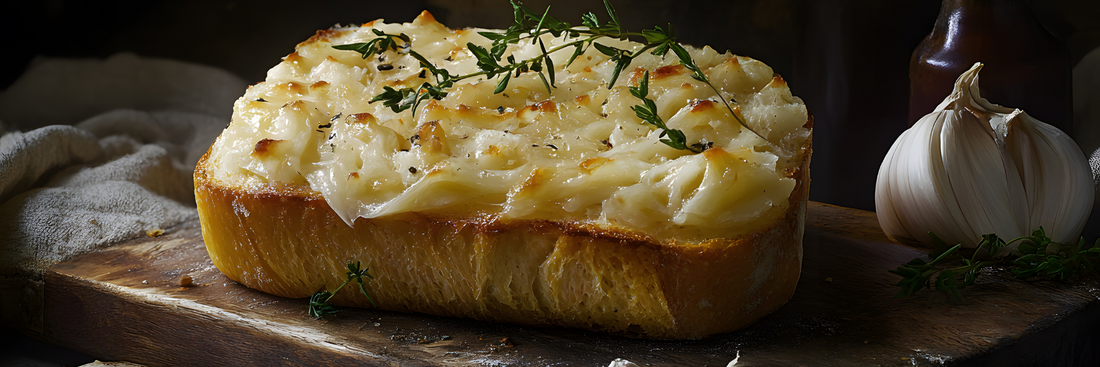Garlic bread is a staple side dish loved for its rich flavor and satisfying crunch. But when it comes to nutrition, many people ask: Is garlic bread healthy? The answer depends on what it's made of and how it's prepared. In this article, we'll break down the calories, fat, and nutrients in garlic bread, explore its health benefits and risks, and offer practical tips to make it a smarter addition to your diet.
Nutrition Profile: Is Garlic Bread Healthy?
Garlic Bread Health Facts
Garlic bread typically delivers 330–351 kcal per 100 g, with 35–38 % of calories from fat, 51–56 % carbohydrates, and 9–11 % protein.
Per 100 g, it contains roughly:
-
12–17 g total fat (including ~2.5–5 g saturated fat)
-
42–46 g carbs, with 2–4 g fiber and ~0.4–4 g sugars
-
7–8 g protein.
It also provides 600 mg sodium per 100 g, around 27–36 % of daily value.
Garlic Bread Calories: How Many Are in Each Slice? Full Breakdown

Antioxidants and Nutrients from Garlic
Garlic is a low-calorie addition—just ~4.5 kcal per 3 g clove—but it contributes potent phytonutrients like allicin, vitamin C, and manganese, which act as antioxidants and may support cardiovascular health and immunity. These benefits are retained in garlic bread even though their caloric impact is minimal.
White vs. Whole Grain Garlic Bread Nutritional Comparison
Whole grain garlic bread offers more fiber, protein, vitamins, and minerals than its white bread counterpart. Per slice:
-
Whole-wheat: ~2–4 g fiber, 4 g protein, ~91 kcal
-
White: <1 g fiber, ~2 g protein, ~75 kcal
Whole-grain options digest more slowly, help control blood sugar, and may support heart health compared to refined white varieties.
Health Benefits of Garlic Bread
Heart Health and Antioxidants in Garlic
The antioxidants in garlic specifically allicin and sulfur compounds have been linked to lower cholesterol and improved heart health, while the fiber in whole grains helps reduce cardiovascular risk.
Immune-Boosting Sulfur Compounds in Garlic
Garlic’s sulfur compounds, like allicin, are recognized for boosting immune function and offering anti-inflammatory and antimicrobial effects—benefits that carry through in garlic bread.
Energy from Carbohydrates vs. Glycemic Impact
Carbohydrates in garlic bread provide quick energy. However, refined grain versions especially white bread are high on the glycemic index and can cause rapid blood sugar spikes. In contrast, whole grain variations release glucose more gradually, making them a better choice for balanced energy and blood sugar control.

Garlic Bread Health Risks
High Fat and Saturated Fat from Butter and Cheese
The high fat content in garlic bread (12–17 g per 100 g), especially saturated fat from butter and cheese, can elevate cholesterol levels and increase heart disease risk.
High-Calorie Density and Potential Weight Gain
With 330–410 kcal per 100 g, garlic bread is calorie-dense. Regular consumption in large portions may contribute to excess calorie intake and weight gain.
Refined Grains and Blood Sugar Spikes
White bread, being a refined grain, lacks fiber and essential nutrients, has a high glycemic index, and can lead to blood sugar spikes, raising risk for diabetes and metabolic conditions.
Sodium Levels and Heart Health
Garlic bread contains high sodium around 610 mg per 100 g (27–36 % of daily value). Consistent overconsumption can raise blood pressure and negatively impact heart health.
How to Make Garlic Bread Healthier
Garlic bread can be made significantly healthier by making a few smart substitutions and preparation choices. Here are four effective ways to improve its nutritional value without sacrificing flavor.
Use Whole Grain or Sourdough Bread
Switching from white bread to whole grain or sourdough increases the fiber, vitamins, and minerals in each slice. Whole grain bread helps regulate blood sugar, supports digestion, and provides longer-lasting energy. Sourdough offers the added benefit of natural fermentation, which can be easier on the digestive system and slightly lower on the glycemic index.
Replace Butter with Olive Oil or Low‑Fat Spread
Traditional garlic bread recipes use butter, which is high in saturated fat. Replacing it with extra virgin olive oil or a low-fat spread reduces saturated fat and adds heart-healthy unsaturated fats. Olive oil also enhances the flavor of garlic and herbs while offering antioxidant benefits.
Limit Cheese, Opt for Fresh Garlic and Herbs
Cheese increases saturated fat, sodium, and calories. To keep garlic bread lighter, use little or no cheese. Instead, focus on fresh garlic, chopped parsley, oregano, or rosemary for flavor. These ingredients are rich in antioxidants and give garlic bread a fragrant, savory profile without added fat.
Portion Control and Baking vs. Frying
Even with healthier ingredients, portion size matters. Stick to one or two slices and avoid oversized servings. Also, choose baking over frying—baking requires less oil and reduces total fat content. Toasting in the oven delivers the crisp texture people love while keeping the recipe lighter.

How Long Does Garlic Bread Last? Storage Tips for Fridge, Freezer & More
FAQs About Are Garlic Bread Healthy
Is garlic bread healthy for cholesterol?
Not typically. Garlic may help lower cholesterol, but butter and cheese in garlic bread are high in saturated fat, which can raise cholesterol levels.
Is garlic bread bad for diabetics?
It can be. White garlic bread is high in refined carbs and may spike blood sugar. Whole grain versions are a better option in moderation.
Can I eat garlic bread every day?
It’s best in moderation. Daily consumption can lead to excess calories, fat, and sodium unless made with healthier ingredients and portion control.
Conclusion
Garlic bread can be both comforting and flavorful, but it's not always the healthiest choice especially when made with white bread, butter, and cheese. While garlic offers antioxidants and potential heart health benefits, these are often outweighed by the high levels of fat, refined carbs, and sodium. By using whole grain bread, olive oil, and fresh herbs, you can enjoy garlic bread in a way that better supports your health goals. Moderation and smart ingredient swaps are key.







